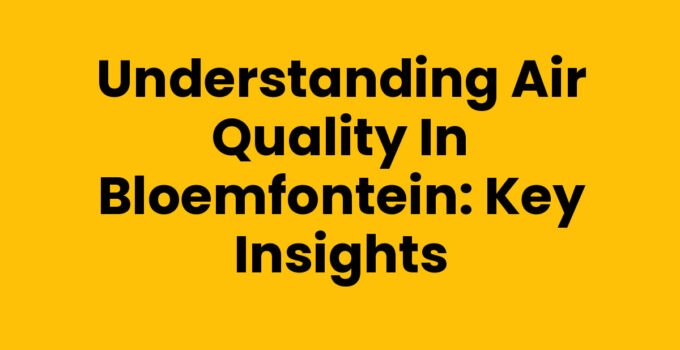Welcome to our in-depth exploration of air quality in Bloemfontein. As the capital city of the Free State province of South Africa, Bloemfontein faces unique environmental challenges that can impact the well-being of its residents. This blog post will provide a thorough examination of air quality in Bloemfontein, its pollutants, health effects, and what can be done to improve it.
Air Quality Bloemfontein: Understanding the Current Situation
The city of Bloemfontein has been grappling with various issues related to air quality. Factors such as industrial emissions, vehicle exhaust, and natural dust contribute to the air pollution levels. The South African Air Quality Information System (SAAQIS) monitors these aspects, providing valuable insights into the city’s air quality.
Current air quality in Bloemfontein frequently fluctuates, especially during the dry seasons. To gain a better understanding, let’s break down the main contributors to air quality issues in the city.
1. Industrial Emissions
Industries surrounding Bloemfontein are significant contributors to air pollution. Manufacturing plants and power generation facilities release particulate matter (PM), sulfur dioxide (SO2), and nitrogen oxides (NOx) into the atmosphere. These pollutants not only diminish air quality but can also pose serious health risks to residents.
2. Traffic Pollution
The increase in vehicular traffic has a profound effect on Bloemfontein’s air quality. Exhaust fumes from cars, buses, and trucks are a major source of ozone and PM. During peak hours, the air quality can deteriorate quickly, leading to increased health concerns, particularly for vulnerable groups.
3. Natural Dust
Bloemfontein also experiences high levels of dust due to its semi-arid climate. Windy conditions can sweep dust from unpaved roads and construction sites into the air, further exacerbating particulate matter concentrations. It is advisable for residents to stay informed and minimize outdoor activities during dust storms.
See Also: Discover the Best Dog Parks Bloemfontein for Your Pup
Steps to Improve Air Quality in Bloemfontein
Improving air quality is a collective effort that involves government intervention, community awareness, and individual actions. Below are actionable steps that can be taken to help mitigate air pollution in Bloemfontein:
1. Enhance Public Transportation
Investing in reliable and efficient public transportation will help reduce the number of vehicles on the road, significantly decreasing traffic emissions. Initiatives like carpooling, biking lanes, and walking paths should be promoted.
2. Promote Green Spaces
Increasing green spaces such as parks and gardens can improve air quality by providing natural filtration for air pollutants. Community planting initiatives can be organized to encourage citizen involvement in beautifying Bloemfontein while enhancing air quality.
3. Educate the Public
Raising awareness about air quality issues is crucial. Community programs should educate the public on how to monitor air quality and the best practices to reduce personal emissions, like using eco-friendly vehicles and reducing energy consumption at home.
Further Reading: Explore Fraser Street, Bloemfontein: A Hidden Gem in the City
Conclusion: A Collective Responsibility
The air quality in Bloemfontein is a pressing issue that requires attention. Understanding the sources of pollution and implementing conscious strategies can make a significant difference. By taking collective action, we can work towards a cleaner and healthier environment for everyone in Bloemfontein. Keep informed, stay proactive, and advocate for policies that support better air quality.
Related Guide: Discover Henry Street, Bloemfontein: A Local Guide
Frequently Asked Questions
What are the main contributors to air pollution in Bloemfontein?
The main contributors are industrial emissions, traffic pollution, and natural dust.
How can I monitor air quality in Bloemfontein?
You can monitor air quality through the South African Air Quality Information System (SAAQIS) and local environmental agencies.
What individual actions can help improve air quality?
Using public transport, reducing energy consumption, and participating in community clean-up efforts can help improve air quality.



